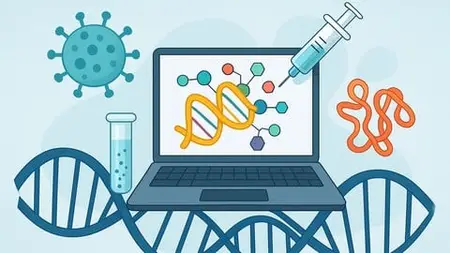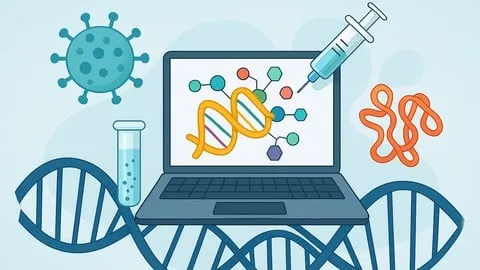Computational Multi-Epitope Vaccine Design
Published 8/2025
MP4 | Video: h264, 1920x1080 | Audio: AAC, 44.1 KHz
Language: English | Size: 1.04 GB | Duration: 1h 23m
Published 8/2025
MP4 | Video: h264, 1920x1080 | Audio: AAC, 44.1 KHz
Language: English | Size: 1.04 GB | Duration: 1h 23m
Master End-to-End Bioinformatics Vaccine Development: From Target Selection to Immune Simulation and Cloning
What you'll learn
Predict B/T-cell epitopes via IEDB and validate safety/immunogenicity with VaxiJen, AllerTOP, and ToxinPred.
Design multi-epitope vaccines using adjuvants (β-defensin), linkers (AAY/EAAAK), and epitope screening workflows.
Execute structural validation: Dock vaccine-TLR4 complexes (HDOCK), run MD simulations (iMODS), and interpret stability metrics (B-factor/deformability).
Simulate immune responses using C-ImmSim to quantify antibody kinetics (IgM/IgG), B/T-cell dynamics, and cytokine profiles.
Perform end-to-end in silico cloning: Optimize codons (JCAT), integrate into pET28a+ vectors, and validate with SnapGene.
Requirements
Basic biology knowledge, introductory immunology, and computer literacy to install/run tools—no coding experience required.
Description
This course immerses you in mastering end-to-end computational vaccinology, focusing on designing clinically relevant multi-epitope vaccines against lethal pathogens like Nipah virus and emerging pandemics. You’ll master immunoinformatics foundations: vaccine immunology, adaptive immunity mechanisms, epitope-paratope interactions, and cross-population MHC-driven immune responses mediated by HLA polymorphisms. Next, pathogen target screening teaches high-throughput surface protein selection, structure-based conservation analysis, human/microbiome homology validation via BLASTP, and regulatory-grade safety profiling (allergenicity/toxicity) using structural bioinformatics.Epitope engineering covers advanced conformational B/T-cell prediction using IEDB, multi-parametric antigenicity/solubility filtering (VaxiJen/PepCalc), and precision vaccine construction with adjuvants (β-defensin) and protease-resistant linkers (AAY/EAAAK) maintaining structural integrity for cold-chain stability. Finally, structural vaccinology includes high-accuracy vaccine-TLR4 docking, molecular dynamics stability simulations (deformability/B-factor/eigenvalue analysis) under physiological conditions, and in silico immunogenicity profiling with C-ImmSim to quantify antibody isotype switching, affinity maturation, and T-cell clonal expansion.The curriculum culminates with GMP-compliant translational bioinformatics: industry-standard codon optimization maximizing CAI, pET28a+ vector cloning, and SnapGene-based expression feasibility validation. All skills are applied through 12 hands-on modules to build a clinically viable Nipah virus vaccine—from target selection to wet-lab-ready constructs—equipping you to tackle COVID-19, influenza, Ebola, or novel pathogens. Graduate with certified, job-ready computational vaccinology expertise for high-impact biopharma or academic research careers in pandemic preparedness, empowering you to develop cost/time-efficient vaccines against antigenically variable pathogens.
Overview
Section 1: Computational Vaccinology Foundations
Lecture 1 Multi-Epitope Vaccines: Computational Design Foundations & Immunology
Section 2: Nipah Virus Pathogenesis & Prevention
Lecture 2 Nipah Virus
Section 3: Computational Vaccine Pipeline Setup
Lecture 3 Multi-Epitope Vaccine Workflow
Section 4: Protein Selection Criteria
Lecture 4 Vaccine Target Selection: Nipah G/N Protein Bioinformatics & Safety Screening
Section 5: B/T-Cell Epitope Prediction: IEDB Workflow
Lecture 5 Computational Epitope Prediction: IEDB for B-Cell & T-Cell Antigen Screening
Section 6: Epitope Safety Screening: Immunoinformatics Tools
Lecture 6 Epitope Safety Screening: Antigenicity, Toxicity & Solubility Prediction
Section 7: Vaccine Construct Assembly: Linkers & Adjuvants
Lecture 7 Multi-Epitope Vaccine Construction: Adjuvant Integration & Linker Design
Section 8: Vaccine Construct Profiling: Safety & Stability
Lecture 8 Vaccine Construct Validation: Immunogenicity & Physicochemical Profiling
Section 9: Vaccine-TLR Docking & MD Simulation Analysis
Lecture 9 TLR4-Vaccine Docking & MD Simulation: HDOCK/iMODS Binding Stability
Section 10: In Silico Immune Simulation: C-ImmSim Profiling
Lecture 10 Vaccine Immune Simulation: C-ImmSim Immunogenicity & Antibody Response Analysis
Section 11: In Silico Cloning & Codon Optimization
Lecture 11 In Silico Vaccine Cloning: pET28a+ Vector Integration & SnapGene Simulation
Section 12: Computational Vaccine Design: Full Pipeline Review
Lecture 12 Multi-Epitope Vaccine Design: End-to-End Computational Pipeline Conclusion
Bioinformaticians, immunologists, virologists, and researchers transitioning to computational vaccinology or pharma/biotech roles.



